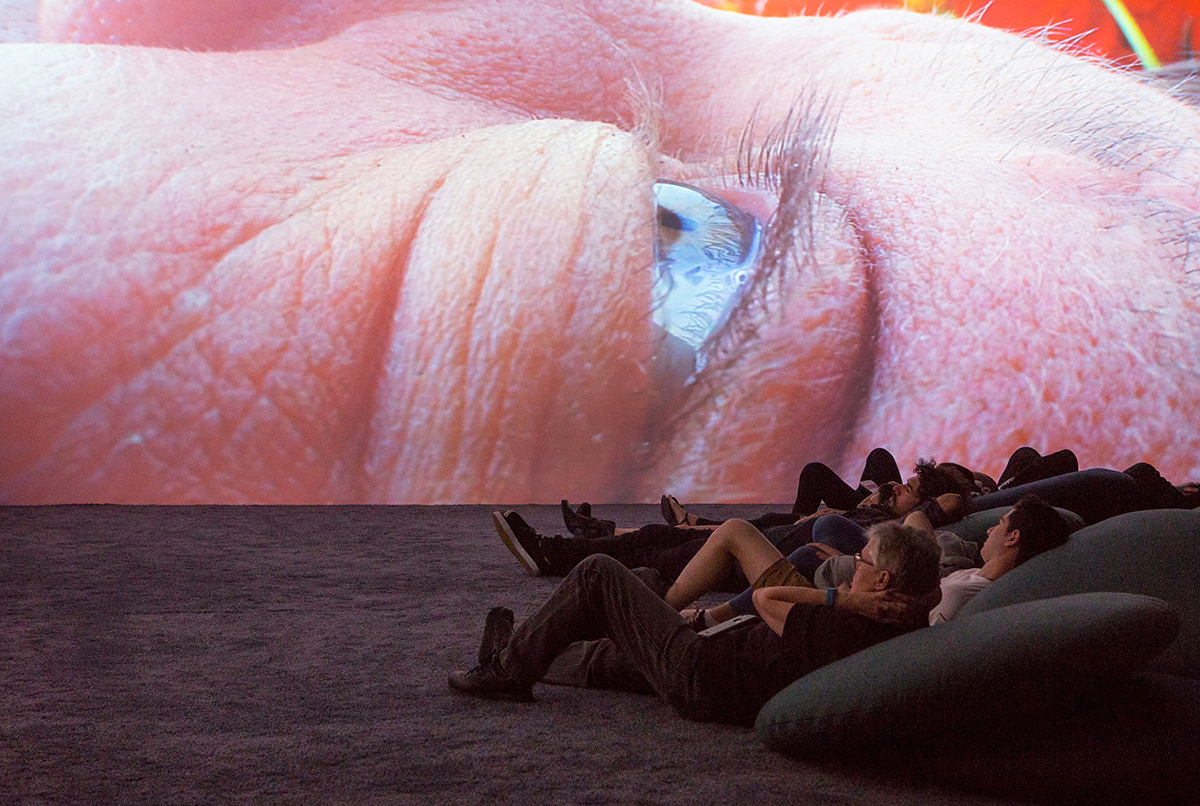
Pipilotti Rist at the MCA: Serious fantasist
Sip my Ocean marks the first major retrospective of the Swiss artist Pipilotti Rist in Sydney. Ironically, prior to this we have only been offered “sips” of her gently transgressive, colour-saturated dream worlds in which the human is playfully reintegrated into nature, but in this current exhibition we are invited to utterly slake our thirst.
At the entrance is Meditation for Suburbbrain (2011), a two-channel work comprising a small projection of the artist, in super close profile, in front of motion-blurry scenery, the details of which are subsequently projected, floor to ceiling, onto the adjoining wall. The projection surface is covered, bas-relief style, in a series of white objects — boxes, packaging, tattered underwear and baby clothes — aesthetic detritus that Rist has titled The Innocent Collection, dating from 1985 to approximately 2032 (the artist’s predicted retirement or demise?). We don’t hear her words but subtitles indicate she is talking about relationships: “All this overblown romanticism,” “Should one end the relationship at its best?” The tone of this work is surprisingly sombre, the colours muted, the text tinged with pessimism — not what we have come to expect from Rist. It introduces a curious melancholy early into the otherwise positively pleasurable sensorium that is the rest of the exhibition.
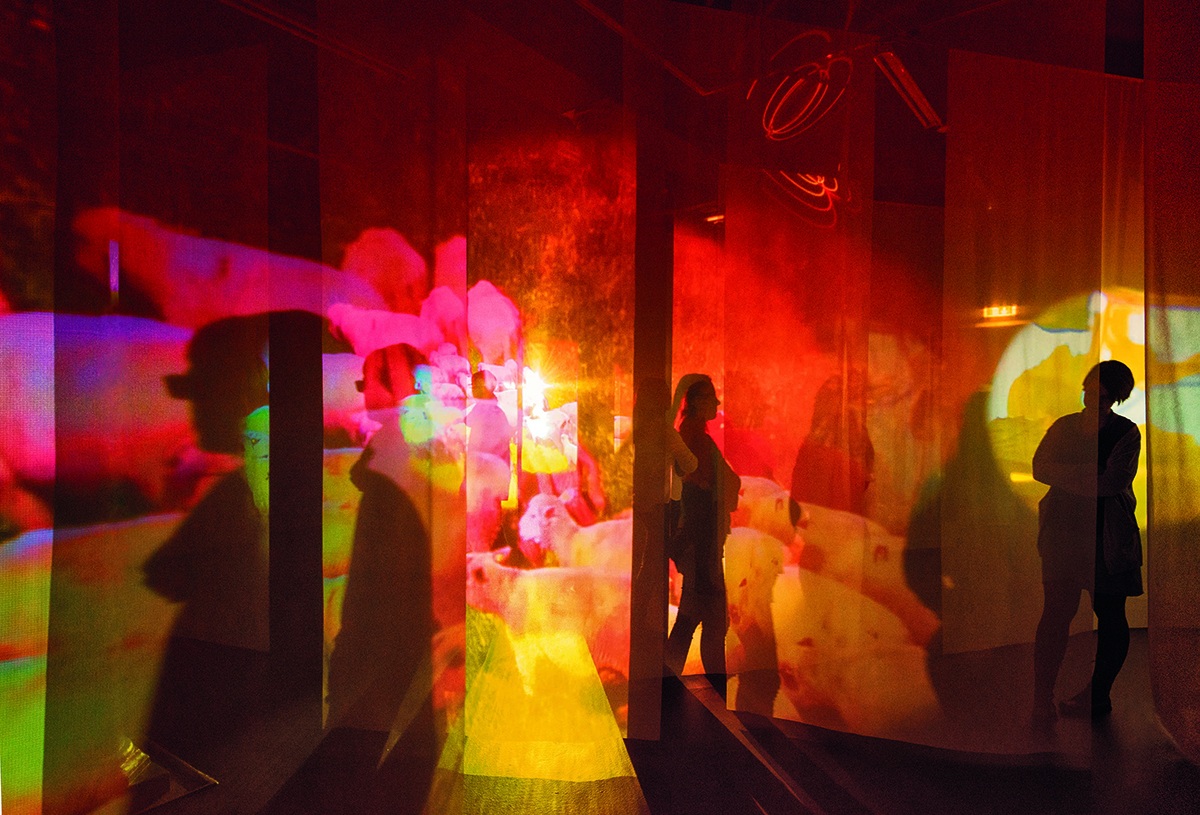
Pipilotti Rist, Administrating Eternity, 2011, image courtesy MCA Sydney
Video hits
Beguiling soundtracks lure us around the corner to experience two of Rist’s best known early works. The video from which the exhibition takes its title, Sip my Ocean (1996), introduces us to the artist’s fondness for underwater scenography, showing a water-baby in sunny yellow bathing suit frolicking among the swirling verdant plants of an azure ocean. It’s bright, idyllic and joyous even as we see plastic cups tumble in the currents and hear the guttural wail of Rist as she reinterprets the Chris Isaak hit “Wicked Game.”
The same jubilance is present in Ever is Over All (1997), in which a gorgeous woman in a 1950s pale blue frock and Dorothy-in-Oz red shoes, skips in graceful slow motion down a sidewalk, joyously smashing car windows with her long-stemmed Kniphofia flower. Fields of these flowers, also known as red hot pokers, streak across the adjoining screen, blurry oranges and reds bleeding onto the edge of the other image. In Rist’s world we will destroy oppression with grace and natural beauty, a secret to which a passing, winking female policewoman is privy. In these works we see the key elements of the artist’s thematic and stylistic oeuvre: the natural world represented by water and flora; smashing of gender constraints and social mores; colour as content; and sound as seduction.
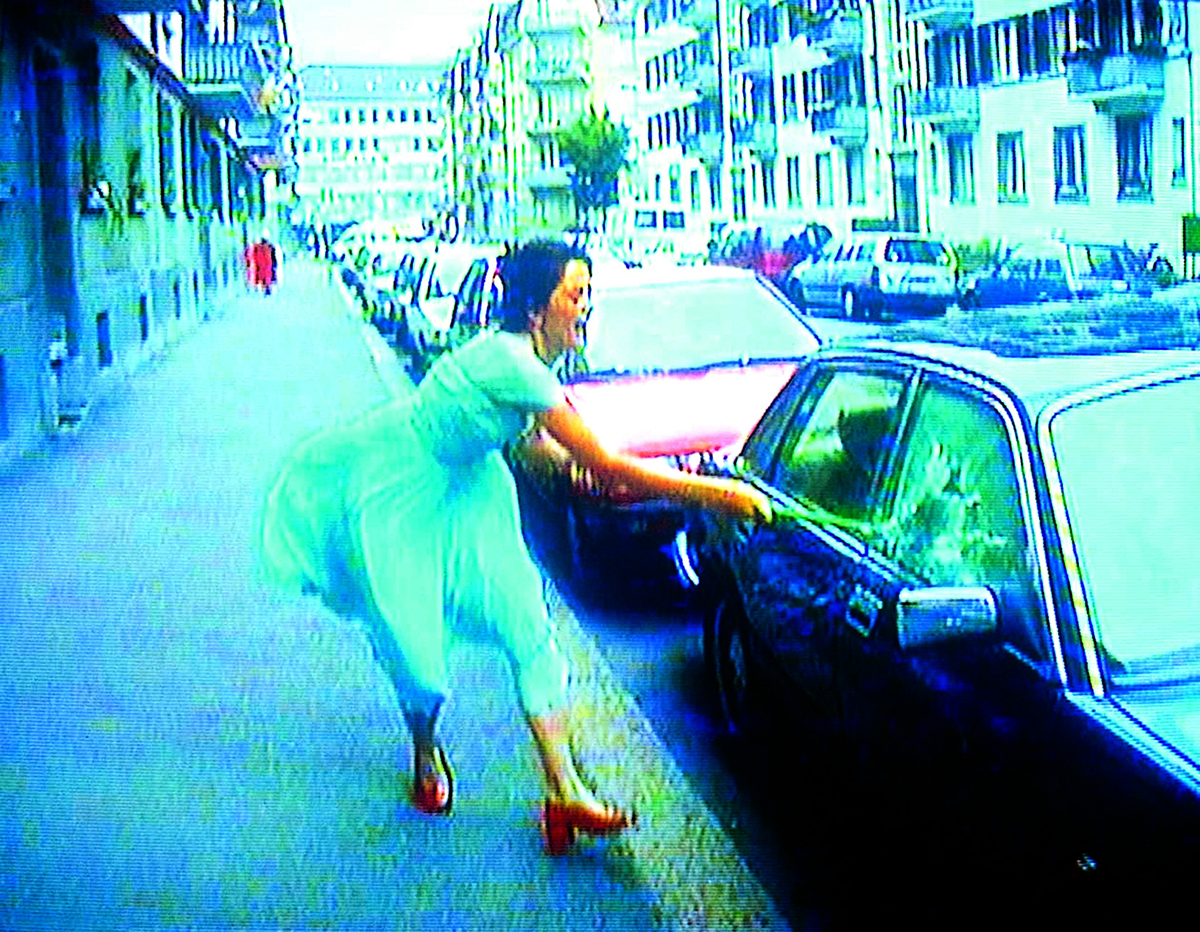
Pipilotti Rist, Ever is Over (still), 1997, image courtesy MCA Sydney
Single channel histories
In a small room on the other side of the entrance is another slice of Rist’s history, Das Zimmer (1994/2017), a selection of 15 single-channel video works and excerpts. Ever attentive to the way in which we watch, she invites us to clamber up onto giant couches and channel-hop via an enormous remote control. I notice many people eschew this room, preferring the more spectacular treats that await further into the exhibition space, but for me these works such as I’m Not the Girl Who Misses Much (1986), PickelPorno (1992) Sexy Sad I (1997) and Open my Glade (1997, the Flatten series), are integral to reading greater depth into Rist’s work as a whole. In these pieces we see the strength of her feminist beliefs and her battle against sexual and moral convention, leavened with a strong dose of play. Perhaps it is the self-conscious quality of early video and its clunky and limited compositing techniques, but in their rawness these works show Rist’s agenda at its most charged and defiant.
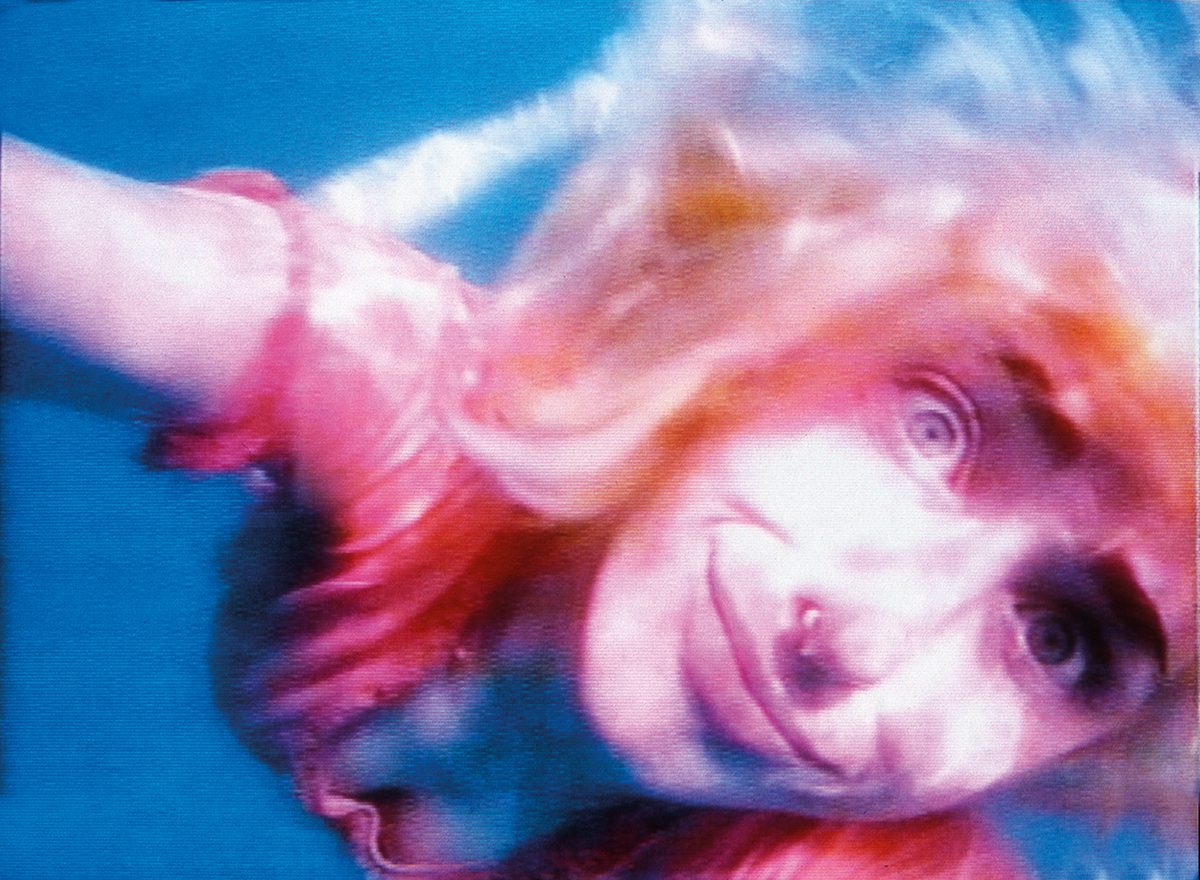
Pipilotti Rist, Sip my Ocean, video still courtesy MCA Sydney
Behind the eyelids, beyond the beauty
Heading further into the exhibition we move away from the flatness of single channel into greater degrees of immersion and three-dimensionality. Marking this shift is the 2011 work Administrating Eternity. For a moment, amid multiple screens made of sheer fabric, fragmenting and diffusing the projections of psychedelic sheep, plant life and geometric patterns, I feel quite happily lost. The gallery walls recede and I am simply surrounded by diaphanous abstractions made from floating colours. For this brief moment I say, yes, this is enough, Rist has succeeded in conjuring the stuff of which dreams are made.
In contrast to the amorphous nature of Administrating Eternity is Sleeping Pollen (2014). While maintaining all Rist’s main concerns in terms of subject matter (the almost excruciating beauty of plant life) and form (fully integrated installation systems with projectors placed inside large mirrored baubles hung like pendulous fruit around the space), this work is startlingly different for its sense of reduction and restraint. Here the plants float in isolation from their environment, as precious, highly detailed specimens on black backgrounds. It is a darkly seductive environment but I struggle to find more meaning beyond the beauty.
Similarly overwhelming is Pixelwald Motherboard (2016). It seems every contemporary art exhibition has to have a work that is perfect for visitor selfies, and this is the one. Three thousand LED lights in sculptural shades (made in collaboration with Kaori Kuwabara) represent pixels of a video image. We are offered a stunning cascade of shifting colours and patterns that Rist intends to appear as an exploded screen or a simplified brain. Though rendered even ‘cooler’ by the (once again) accompanying Chris Isaak cover from Sip my Ocean, it’s another work that fails to resonate beyond its remarkable aesthetics and technical execution.
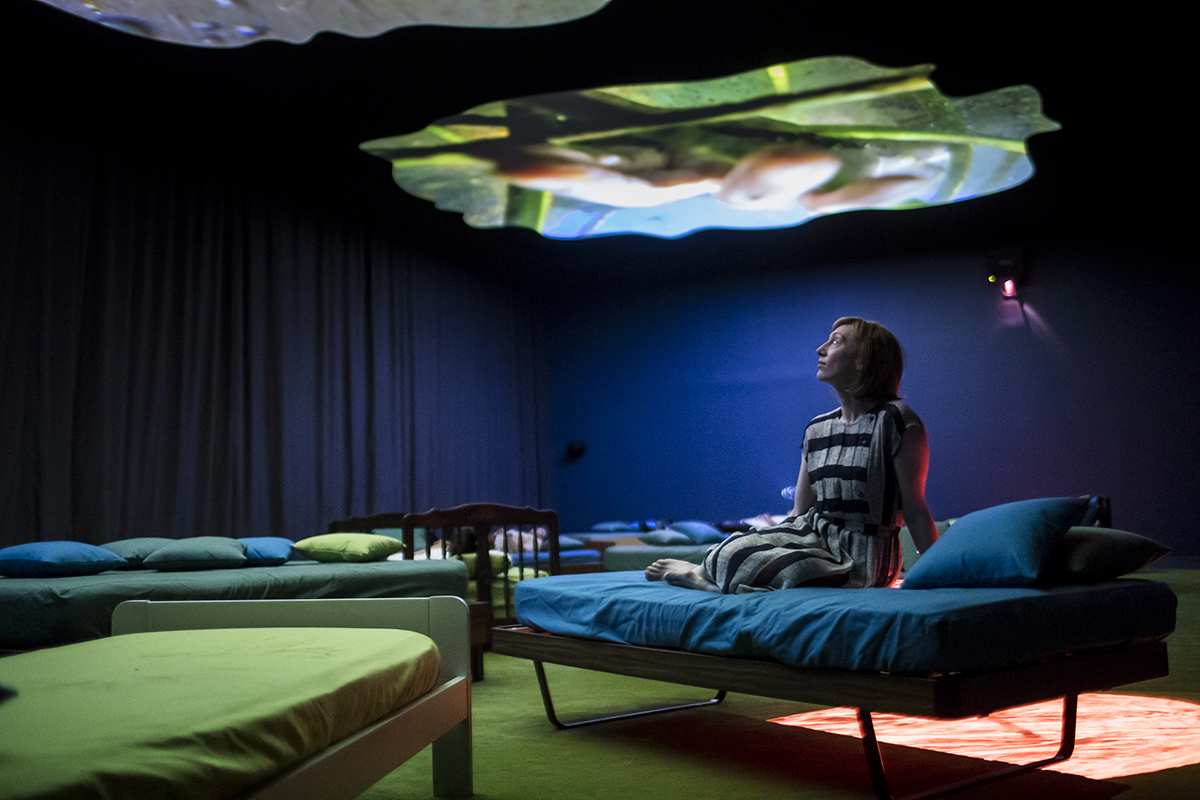
Pipilotti Rist, Sip my Ocean, installation image Ken Leanfore courtesy MCA Sydney
Worlds made of worlds
At the end of the gallery space a small neon sign implores “help me” and we proceed through a maze-like curtained corridor to emerge into a massive assemblage of works collected under the title Your Room Opposite the Opera. Comprising 14 pieces made between 1994 and 2017, this room alone represents a Rist retrospective. More than a wunderkammer it is a wunderzimmer: a dining table becomes a kaleidoscope; a gin bottle glows with botanic lifeforms; a bed is blanketed with a whole universe; a mobile of underpants whirls with colour; no surface is safe from projection. Beneath our feet, in a tiny hole in the floor, a miniature, naked Rist looks up, yelling to us from the depths of hell (maybe this is the origin of the call for help?). These moments of magic are scattered among books, vases and knick-nacks and we are invited to sit in lounge chairs to become part of the decor.
At the far end of the space, the perpendicular walls form a screening space for Another Body from the Lobe of the Lung Family (2009). The segment I view involves a very cute piglet gambolling in a meadow in extreme close-up on one screen and a naked, nubile young woman doing the same on the other, I witness a toddler, around 18 months old, run screaming with joy towards the enormous piglet. At that moment the screens swap. He stops for a minute, looking at the enormous woman, and then resumes his joyous squealing — it’s all the same to him. A little later I notice what I think is a curious sea slug, and then realise it is in fact a bobbing penis and testicles. In this video Rist has certainly achieved her ongoing aim of fusing the human and natural world.
Following the neon sign to “trust me” we negotiate another curtained maze to encounter 4th Floor to Mildness (2016). We are invited to kick off our shoes and lie on beds to look up at the ceiling projections. A kind of sequel to the video Sip my Ocean, here we are under the Old Rhine rather than the sea. It’s a slightly more fetid world of slimy weeds and tattered lily pads, yet no less visceral and sensual. At times flesh pink pigment is introduced into the water, swirling in clouds through which a breast may emerge, or Rist’s more mature face, or her slightly more weathered hand. In Sip my Ocean the camera follows behind, chasing the image, but 4th Floor to Mildness (2016) is filmed from below looking up at a liquid sky, with little camera movement. This allows us to float, peacefully, almost ambivalently, as we become one with the primordial soup. The soundtrack is also more melancholic. Mixed in with bubbles of submersion are two wistful folk-pop songs by a group called Soap&Skin that allude to lost childhood, memory and nostalgia.
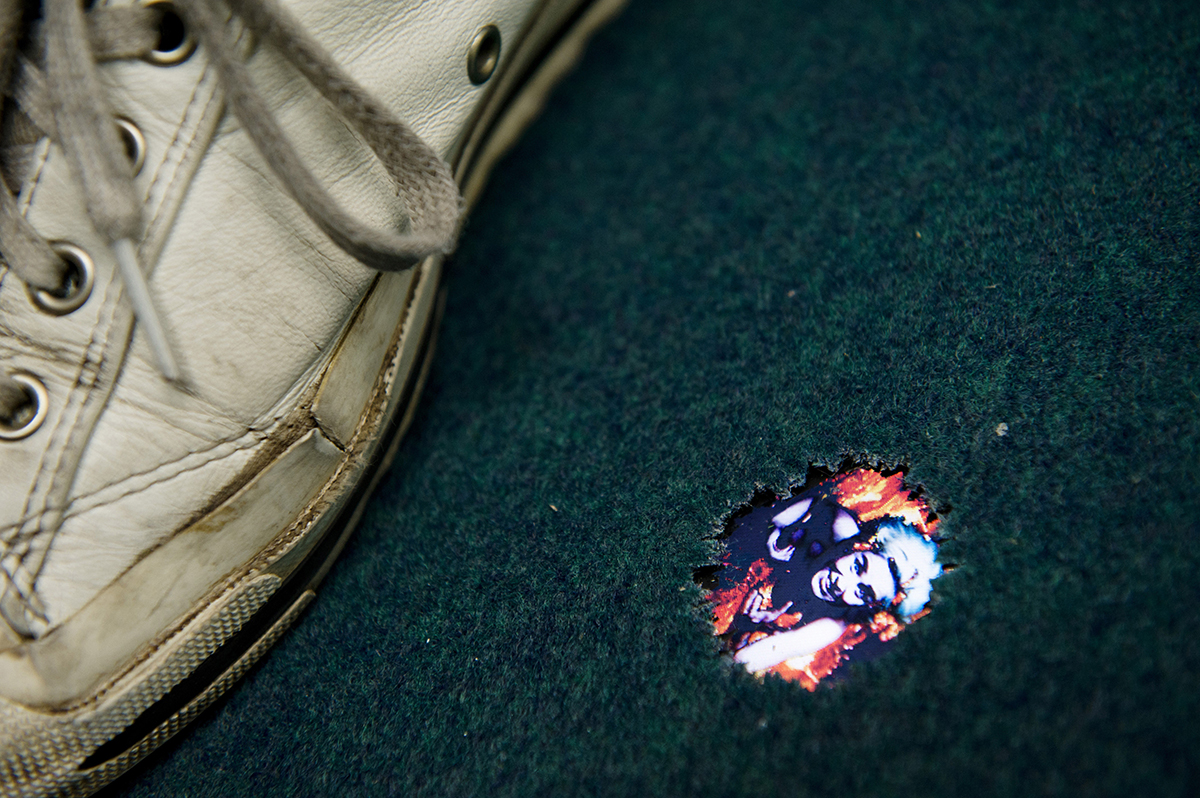
Pipilotti Rist, Selfless in the Bath of Lava, image courtesy MCA Sydney
A crack in the oeuvre
It’s in 4th Floor to Mildness that I find the connection to the discord sensed in Meditation for Suburbbrain. This is an older Rist with a touch of disillusionment perhaps, or simply resignation to being one who sees differently. And this is perhaps what I’m seeking more of in the exhibition as a whole — more of a sense of stress fractures in this fantasy world. Sip my Ocean is indisputably a stunning exhibition full of sensuousness, beauty and wonder, but reflecting on the development of Pipilotti Rist’s oeuvre, as the exhibition deftly allows us to do, leaves me feeling that as the works get bigger and the technology more complex, the more abject aspects, the dangerous ideas, so clear and raw in the earlier works, become codified and aestheticised.
Listening afterwards to the artist’s commentary on the excellent online guide, I am enlightened as to the deeper intentions of Rist’s later works, which at the time of viewing read to me as variations on a theme. Perhaps in seeing such a generous selection of works there’s a danger that, easily overwhelmed by the accumulation of style, we are left with a simplified impression.
By Rist’s own admission, her work is primarily about fantasy. In the audio guide she says, “I don’t think artists have more fantasy than no[n]-artists, but it’s our job to take it seriously and to try to materialise it.” Judged on these terms, there is certainly no denying that the Pipilotti Rist catalogue exhibits seriously fantastic(al) art, offering undeniable sensory pleasures.
–
MCA, Pipilotti Rist, Sip my Ocean, curator Natasha Bullock; Museum of Contemporary Art, Sydney, 1 Nov 2017-20 Feb 2018
Top image credit: Pipilotti Rist, Sip my Ocean, installation image Jessica Maurer courtesy MCA Sydney






